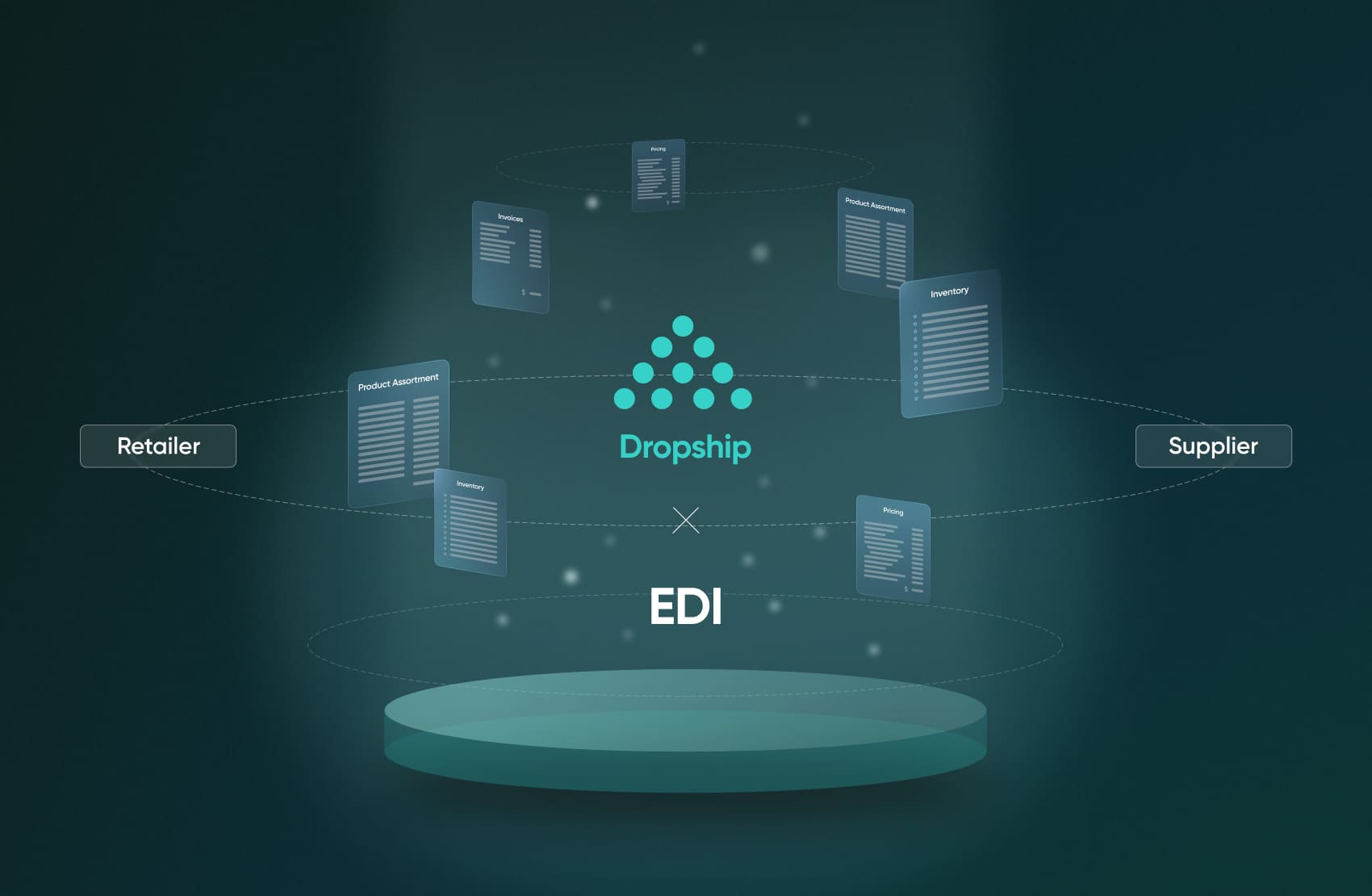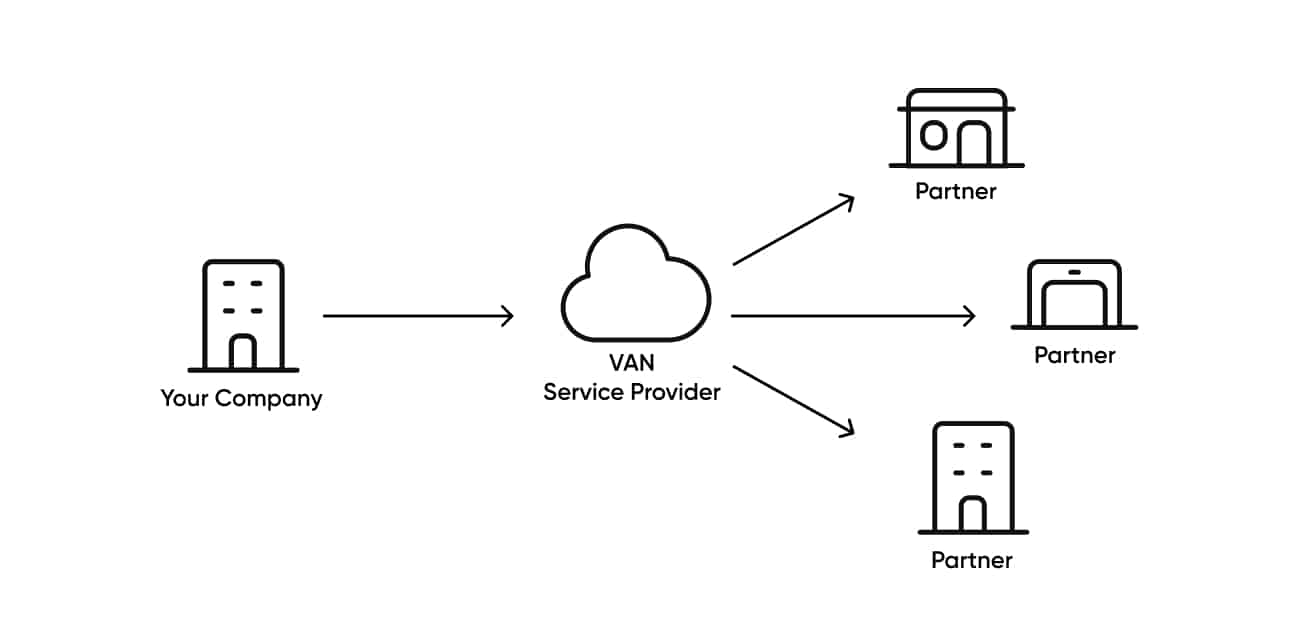Dropshipping Integration: Connecting EDI with fabric Dropship

EDI enables companies to exchange business documents, streamline their dropship operations, and transfer order data to ERPs or other financial platforms.
An EDI connection is a must-have for companies that want to partner with enterprise-scale suppliers and retailers. It accounts for 76.5% of all B2B digital sales.
fabric Dropship offers seamless EDI connections to 500+ vendors and supports a range of EDI transaction sets in the manufacturing and retail industries
Direct integrations with Shopify, BigCommerce, and WooCommerce, and support for EDI, API, XML, CSV, and ShipStation, enable businesses to satisfy dropship requirements for virtually any supplier or retailer.
[toc-embed headline=”What is EDI?”]
What is EDI?
EDI stands for Electronic Data Interchange. First introduced in the 1960s to support shipment supply chains in the US military, it is a system of exchanging business documents electronically between different companies, organizations, or trading partners.
EDI is used to automate and streamline business processes, such as ordering, invoicing, and shipping, by replacing traditional paper-based documents with electronic documents that can be easily exchanged and processed by computers. It helps to improve the efficiency, accuracy, and speed of business transactions while reducing costs and errors associated with manual data entry and paper-based processes.
EDI has long been a solution in e-commerce for enterprise retailer and supplier order management and communication. In a dropshipping context. EDI allows companies to easily and reliably exchange business documents, such as purchase orders and invoices, and transfer data to internal financial or enterprise resource planning (ERP) platforms.
In fact, EDI continues to dominate B2B digital sales and was the biggest electronic sales channel in 2021. It accounted for 76.5% of all digital sales, generating a staggering $8.38 trillion.
[toc-embed headline=”How Does EDI Work for Dropshipping?”]
How Does EDI Work for Dropshipping?
Dropshipping is a fulfillment method where the retailer sells products but doesn’t keep the items it sells in stock. Instead, orders are sent to a dropship supplier who ships them directly to the customer.
Many dropshipping suppliers and retailers communicate via EDI, which supports the fast, accurate transfer of information. It allows businesses to send, receive, and process purchase orders, shipment notifications and confirmations, order adjustments and changes, and invoices.
EDI is a critical piece of the dropship puzzle. Typically, a company will collect and organize the data that will be used to build an EDI document, then that data is translated into EDI format either with translator software or with an EDI service provider. The resulting EDI document is then transmitted via a connection with a business partner. Some of the benefits of using EDI include:
- Lower operating costs
- Improved business cycle speeds
- Less human error and improved record accuracy
- Increased business efficiency
- Enhanced transaction security
- Reduced paper-based transactions
At a very high level, a typical EDI dropship process goes as follows:
- 1. A retailer receives an order and sends a purchase order as an EDI 850 file to their supplier.
- 2. The supplier will confirm that they received the order with an EDI 855 order acknowledgment document, start preparing the order, and send the retailer an EDI 810 invoice file.
- 3. When the order is shipped, the supplier will transmit an EDI 856 shipment notification to the retailer, which prompts the retailer to process the invoice and email the customer an update.
- 4. The retailer validates that the product arrived according to specification. If not, they will request a supplier chargeback.
To give you a more comprehensive picture of how EDI is used in a dropshipping context, let’s walk through several common EDI documents in more detail.
EDI 850 Purchase Order
EDI 850 is a virtual purchase order document. Retailers send an EDI 850 to place orders with their suppliers, outlining what product they need, how many of that product they need, and where to ship the order. The PO number on the EDI 850 document serves as an identifier for that particular order throughout its lifecycle, even if the retailer makes adjustments to their request.
Because EDI 850 is formatted in a standardized way, suppliers don’t have to spend time sifting through documents to figure out what the retailer wants — they know they are receiving a PO and can process the purchase accordingly.
EDI 855 Purchase Order Acknowledgement
Buyers want confirmation that sellers received their EDI 850, or PO. Once a seller gets an EDI 850, they respond to the buyer with an EDI 855, which represents an order acknowledgment. Within the EDI 855, the seller can let the buyer know whether their purchase order was rejected, requires more information, needs changes, or was accepted.
An EDI 850 may be rejected because of:
- Discontinued or non-available items
- Pricing updates
- Backordered items
- Unknown or inaccurate product details
- Delivery date change requests
EDI 810 Invoice
Whenever a retailer buys something from a seller, they expect to receive an invoice that includes the total amount due and the agreed-upon payment terms. EDI 810s typically also include:
- Buyer-related information
- Applied discounts
- Order quantities and prices
- Preferred payment methods
- Tax information
EDI 856 Advanced Ship Notice (ASN)
When a supplier is ready to ship an order they send the buyer an EDI 856, also known as an advance ship notice (ASN). That way, the buyer can be ready to receive and inspect the product at their store or distribution center. EDI 856 documents normally list the shipping date, expected delivery date, shipment number, ship from and ship to addresses, purchase order number, order details, and shipment tracking numbers.
EDI 860 Purchase Order Change Request
Sometimes retailers need to make an update to their original order. In that case, they will send a supplier an EDI 860, or a PO change request. Within the EDI 860 document, the retailer will note the PO number, product quantities, and type changes that need to be made, price changes, reasons for any changes, and a rescheduled delivery date.
[toc-embed headline=”What are the Drawbacks of EDI in Dropshipping?”]
What are the Drawbacks of EDI in Dropshipping?
Although EDI has revolutionized trade partner communication and remains the industry standard for most companies, there are disadvantages. First, it’s a dated system for data exchange, which is why many smaller retailers and suppliers don’t use EDI. They’ve adopted newer document and data transfer technologies such as APIs instead.
API (Application Programming Interface) is a set of protocols, routines, and tools for building software applications that specify how different software programs can interact with each other by exchanging information and functionality. However, while APIs allow retailers to connect with other smaller vendors and suppliers, they can’t work with bigger suppliers that have worked with EDI for a long time and won’t be moving to an API-based model soon. Similarly, suppliers and vendors that want to work with enterprise-scale retailers need to support EDI as well.
Another downside to EDI is its cost. Adopting the EDI format itself may not be that pricey, but most companies require a Value Added Network or VAN to facilitate communications. Think of a VAN as a carrier and an EDI platform as a cell phone. Companies need VANs to aggregate EDI documents and direct them to the correct recipient—just as you need a carrier to send your text messages.

For a traditional retail model that includes large purchase orders, this expense can generally be absorbed through large transactions between retailers and suppliers. However, dropshipping can involve thousands of connections with many small purchase orders. As dropship programs scale, VAN expenses can increase substantially.
Solution: modern dropshipping platforms
Utilizing a modern dropshipping platform can help businesses overcome many of these challenges.
For example, companies don’t need to change internal systems to satisfy the dropship requirements of their trading partners because some of the top dropshipping marketplace solutions are completely agnostic to whatever data exchange protocols businesses want to use. This means a company that trades exclusively with EDI can do business with a company that uses APIs because the platform can seamlessly facilitate the exchange of business communications between the two parties.
The exorbitant fees of VANs can be drastically reduced as well. Since dropshipping platforms with robust support for EDI function much like value added networks, companies that choose to power their dropship programs with a marketplace SaaS provider can gain all the benefits of a VAN but without the cost.
Finally, suppliers and retailers can use less IT resources for building integrations and other resource-intensive tasks. White-glove, personalized onboarding as well as turnkey integrations with vendors, shipping providers, services, and e-commerce platforms can be fully managed by the top dropshipping marketplace platforms, essentially freeing up internal resources to focus on more strategic business objectives.
[toc-embed headline=”Why is EDI Still Relevant for Dropshipping Today?”]
Why is EDI Still Relevant for Dropshipping Today?
Many of today’s modern dropshipping technology platforms have embraced an API-first approach to developing solutions with the end goal of API consumption in mind. However, the SaaS industry’s focus on building robust APIs means that there’s a lack of EDI support, which is why they encourage as many retailers and suppliers as possible to steer clear of it.
Although REST APIs and JSON are more modern ways of transmitting information between organizations and systems, EDI is still the preferred method of data exchange among enterprise e-commerce businesses. EDI has been around since the early days of e-commerce, and many enterprise retailers and suppliers have it deeply integrated with the financial systems, legacy ERPs, and OMS platforms they use to power their businesses.
While moving to an API-based model is possible for these organizations, it would require a massive, costly transition that many are not ready to undertake. Ripping and replacing EDI would be far too time- and resource-intensive. As the saying goes: if it’s not broke, don’t fix it.
The reality is that EDI is still a viable solution for large suppliers and retailers, and without a major incentive to change, EDI in the enterprise space is likely to stick around for years to come. For example, retailers that support EDI communications can work with practically any large enterprise dropship supplier. VF Corp uses EDI and it is one largest apparel, footwear, and accessories suppliers in the world. Some of its iconic brands include Vans, The North Face, Timberland, and Supreme.
Similarly, major retail brands such as Nordstrom, Macy’s and Bloomingdale’s, and Saks Fifth Avenue use EDI, which means that suppliers would require EDI integrations to do business with them as well.
[toc-embed headline=”Where Retailers Encounter EDI With Dropshipping”]
Where Retailers Encounter EDI With Dropshipping
Today, more and more retailers are exploring dropship platforms like fabric Dropship because of their prebuilt API connections to Shopify, BigCommerce, and WooCommerce. Many of the SMB and mid-market-sized suppliers that retailers want to engage with are using one of those platforms, making communication between the parties simple and effective.
But large, long-standing dropship suppliers are not moving to an API-based dropshipping model any time soon. For a vast number of enterprise-scale suppliers, EDI is inextricably linked to their financial backbones, making it highly unlikely they will overhaul their data exchange protocols.
In other words, while a retailer’s dropship platform may support APIs, those integrations will not be sufficient to play in the enterprise space. Without robust EDI support through a modern dropshipping platform, retailers would need to employ the technical resources to design and launch custom integrations with enterprise suppliers. To scale their dropshipping businesses beyond the SMB size, a dropship solution with an EDI connection is an absolute must.
[toc-embed headline=”Why fabric Dropship?”]
Why fabric Dropship?
The name of the game in dropshipping is connectivity. To maximize revenue and accelerate time-to-market, retailers and suppliers should be free to connect and trade in open marketplaces with as few restrictions as possible. But without the ability to communicate through EDI, companies will encounter difficulties when trying to partner with enterprise-sized suppliers and retailers.
That’s where fabric Dropship comes in.
fabric Dropship is built to be completely agnostic and is capable of supporting all customers—however they want to connect and exchange data with their technology stacks. That means that if your trading partner uses EDI, you don’t necessarily need to adopt EDI yourself. You can simply use your existing systems and the platform will facilitate all transactional information between partners.
In fact, fabric Dropship has over 500 EDI connections to a variety of vendors, so implementing a robust, intuitive EDI integration is quick and seamless and eliminates the need to hire developers to build custom integrations. Furthermore, native EDI integrations have relatively easy maintenance; admins can easily make any necessary changes themselves without substantial IT help.
fabric Dropship also has robust API functionality and direct integrations with Shopify, BigCommerce, and WooCommerce. By supporting protocols such as EDI, API, XML, CSV, ShipStation, or even a web portal, it allows customers to directly integrate with any dropship supplier or retailer of their choice. Additionally, fabric’s customer success and supplier onboarding teams make implementation and supplier adoption smooth and efficient.
For these reasons, fabric Dropship is one of the fastest and most complete solutions for retailers to launch a successful dropshipping program backed by an unlimited number of suppliers. It is also the preferred platform for suppliers and vendors that want to maximize their reach across as many retailers as possible.
Are you curious about how fabric can take your dropshipping program to the next level?
Request a demo to see the depth and breadth of fabric Dropship for yourself.

PIM product manager @ fabric. Previously VP of products @ Ubreathe.
